OSLO, Norway — On Sept. 11, Soundware Norway proved that it was possible to run a live radio broadcast using the touchscreen monitor inside a Tesla 3 electric car.
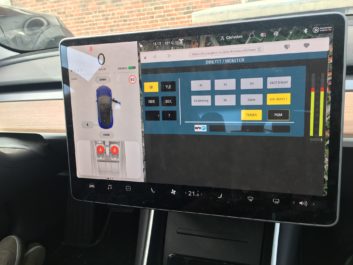
Inside the Tesla parked outside Soundware Norway’s Oslo headquarters, Soundware Sales Manager Ketil Morstøl managed a mock live broadcast using the Tesla 3’s web browser, which accesses the web via the car’s built-in LTE wireless modem. The browser was connected to a website hosting Soundware’s DHD user interface that remotely controls a DHD-equipped radio production facility, and David Systems’ TurboPlayer playout system.
Using the touchscreen display — which showed a standard radio music playlist in the center of the screen and standard on-air control buttons to switch/fade between audio sources and turn microphones on and off on the right side — Morstøl cycled through the functions just as if he was doing a live radio broadcast.
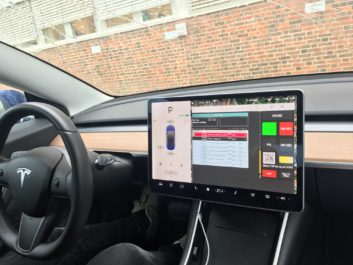
“As a proof that we have bidirectional audio, we can switch on the microphone and we will actually see the PPM meter showing the input signal,” said Morstøl in a YouTube video entitled “Soundware Norway to Do BroadCARst as World First!” (Available here.) The microphone was sourced from Morstøl’s own smartphone, which connected to the web browser by taking a photo of an onscreen QR code.
MORE THAN A STUNT
Given that this “broadCARst” was staged to promote Soundware Norway’s appearance at IBC2019, it is easy to dismiss this demonstration as a publicity stunt. But the broadCARst was much more than that: It showed that radio talent can now take remote control of their station’s live production facilities from any location and run the broadcast as if they were actually in studio themselves.
Soundware Norway was able to do this demo inside a Tesla 3 because this car has a built-in web browser on its touchscreen display. This same functionality can be accessed using a web-connected laptop, tablet, or smartphone. Had he chosen to, Morstøl could have run this demo on a Samsung Family Hub refrigerator — because this fridge has a web-connected touchscreen display built in. “We have pictures of us on Linkedin.com, running a radio studio remotely inside a Boeing 747 at 30,000 feet,” he said.
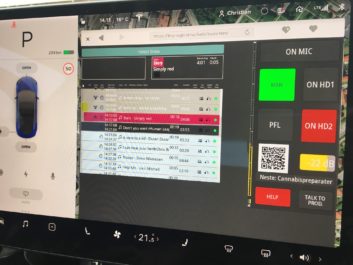
“You can do everything remotely using our DHD interface that you can do in the studio,” Morstøl added. “This goes far beyond choosing songs and opening the microphones. You can actually access the mixing desk in the studio, and make and receive telephone calls. We have even integrated an audio codec into the system so that transporting audio data across the web to the studio is easily enabled.”
MORE THAN A RADIO REMOTE
Broadcasting radio programs from remote locations is nothing new. The first “radio remote” is believed to have taken place in 1924, when WHN (New York City) station manager Nils Granlund leased Western Union telegraph lines to connect his station to local jazz nightclubs.
Producing complex radio broadcasts from remote locations is also standard fare in the broadcasting industry, where fully mixed programs are relayed back to the studio for direct airing. So if Soundware Norway’s DHD system did nothing more than this — turning a Tesla 3 into a radio production studio on wheels — it would be impressive, but not ground-breaking.
However, the Soundware demo showed that the Tesla 3 could serve as a web-based interface for complete remotely controlled radio production; just as the other web-connected devices cited above could.
And this is where the demo gets interesting — because it proves that physical radio production facilities operated by broadcasters who have to be on-site are no longer necessary. Rather than building a 24/7 radio station whose production facilities are only used for live broadcasts at peak hours and otherwise left unused, Soundware’s production model makes it possible to use an unmanned “production hub” whose equipment is accessed remotely as needed, and by multiple users/stations at different times of the day.
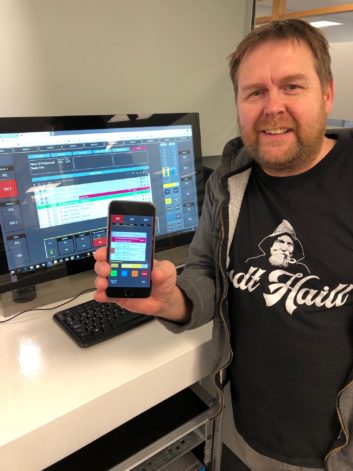
“Rather in a specific radio station investing in production hardware that is unused most of the day, you could share the costs of hardware across broadcasters and all use a common facility,” said Morstøl.
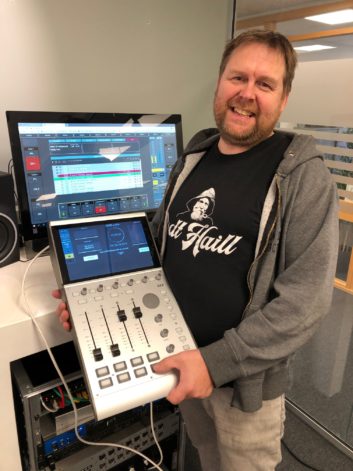
To cope with the fact that radio broadcasters need production facilities for live morning shows, stations operating in different time zones around the world could do the sharing. As long as Station A is four hours (time zones) ahead of Station B, both could use the same remote production facility sequentially for their four hour-long morning shows.
This same function could be provided by third-party vendors. They could create cloud-based virtual production facilities that radio stations could access remotely, with the mixed radio feeds going directly to their transmitter sites via IP.
Should this come to pass, radio stations would no longer need physical radio production facilities. They could reduce their operations to sales/administration offices and transmitter/antenna sites, with engineering staff located there to handle the remaining physical aspects of radio broadcasting.
This said, there’s no reason that on-air talent could not broadcast from the sales/administration office using a laptop, tablet, or smartphone to maintain the public fiction of actually broadcasting from a radio studio. But it would be a fiction, because the creation of fully remote radio production has made the continued existence of physical radio studios optional at the very least, and unnecessary at most.
This may seem a lot to conclude from a mock radio broadcast from inside a Tesla 3. But the far-reaching implications of Soundware Norway’s demo are there for all to see.







